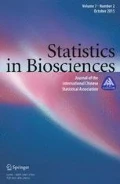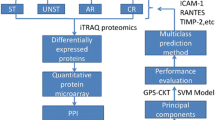Abstract
Identifying novel biomarkers to predict renal graft survival is important in post-transplant clinical practice. Serum creatinine, currently the most popular surrogate biomarker, offers limited information on the underlying allograft profiles. It is known to perform unsatisfactorily to predict renal function. In this paper, we apply a LASSO machine-learning algorithm in the Cox proportional hazards model to identify promising proteins that are associated with the hazard of allograft loss after renal transplantation, motivated by a clinical pilot study that collected 47 patients receiving renal transplants at the University of Michigan Hospital. We assess the association of 17 proteins previously identified by Cibrik et al. (PROTEOMICS Clin Appl 7(11–12): 839–849, 2013) with allograft rejection in our regularized Cox regression analysis, where the LASSO variable selection method is applied to select important proteins that predict the hazard of allograft loss. We also develop a post-selection inference to further investigate the statistical significance of the proteins on the hazard of allograft loss, and conclude that two proteins KIM-1 and VEGF-R2 are important protein markers for risk prediction.


Similar content being viewed by others
References
Bonventre JV (2003) Dedifferentiation and proliferation of surviving epithelial cells in acute renal failure. J Am Soc Nephrol 14(suppl 1):S55–S61
Bonventre JV (2009) Kidney injury molecule-1 (KIM-1): a urinary biomarker and much more. Nephrol Dial Transplant 24(11):3265–3268
Breiman L et al (1996) Heuristics of instability and stabilization in model selection. Ann Stat 24(6):2350–2383
Cheng O, Thuillier R, Sampson E, Schultz G, Ruiz P, Zhang X, Yuen PS, Mannon RB (2006) Connective tissue growth factor is a biomarker and mediator of kidney allograft fibrosis. Am J Transplant 6(10):2292–2306
Cibrik DM, Warner RL, Kommareddi M, Song P, Luan FL, Johnson KJ (2013) Identification of a protein signature in renal allograft rejection. PROTEOMICS Clin Appl 7(11–12):839–849
Cox DR (1972) Regression models and life-tables. J R Stat Soc Ser B (Methodol) 34(2):187–220
Cox DR (1975) Partial likelihood. Biometrika 62(2):269–276
Dadhania D, Snopkowski C, Ding R, Muthukumar T, Lee J, Bang H, Sharma VK, Seshan S, August P, Kapur S, Suthanthiran M (2010) Validation of noninvasive diagnosis of BK virus nephropathy and identification of prognostic biomarkers. Transplantation 90(2):189
Efron B, Hastie T, Johnstone I, Tibshirani R et al (2004) Least angle regression. Ann Stat 32(2):407–499
Fan J, Li R (2002) Variable selection for Cox’s proportional hazards model and frailty model. Ann Stat 30(1):74–99
Faraggi D, Simon R (1998) Bayesian variable selection method for censored survival data. Biometrics 54(4):1475–1485
Foxall PJD, Mellotte GJ, Bending MR, Lindon JC, Nicholson JK (1993) Nmr spectroscopy as a novel approach to the monitoring of renal transplant function. Kidney Int 43:234–234
Garcia RI, Ibrahim JG, Zhu H (2010) Variable selection for regression models with missing data. Stat Sin 20(1):149
Grambsch PM, Therneau TM (1994) Proportional hazards tests and diagnostics based on weighted residuals. Biometrika 81(1):515–526
Han WK, Bailly V, Abichandani R, Thadhani R, Bonventre JV (2002) Kidney injury molecule-1 (KIM-1): a novel biomarker for human renal proximal tubule injury. Kidney Int 62(1):237–244
Honda T, Härdle WK (2014) Variable selection in Cox regression models with varying coefficients. J Stat Plan Inference 148:67–81
Ibrahim JG, Chen MH, MacEachern SN (1999) Bayesian variable selection for proportional hazards models. Can J Stat (La Revue Canadienne de Statistique) 27(4):701–717
Ichimura T, Hung CC, Yang SA, Stevens JL, Bonventre JV (2004) Kidney injury molecule-1: a tissue and urinary biomarker for nephrotoxicant-induced renal injury. Am J Physiol Ren Physiol 286(3):F552–F563
Kang DH, Hughes J, Mazzali M, Schreiner GF, Johnson RJ (2001) Impaired angiogenesis in the remnant kidney model: II. vascular endothelial growth factor administration reduces renal fibrosis and stabilizes renal function. J Am Soc Nephrol 12(7):1448–1457
Kim YG, Suga SI, Kang DH, Jefferson JA, Mazzali M, Gordon KL, Matsui K, Breiteneder-Geleff S, Shankland SJ, Hughes J, Hughes D, Schreiner GF, Johnson RJ (2000) Vascular endothelial growth factor accelerates renal recovery in experimental thrombotic microangiopathy1. Kidney Int 58(6):2390–2399
Li B, Hartono C, Ding R, Sharma VK, Ramaswamy R, Qian B, Serur D, Mouradian J, Schwartz JE, Suthanthiran M (2001) Noninvasive diagnosis of renal-allograft rejection by measurement of messenger rna for perforin and granzyme b in urine. N Engl J Med 344(13):947–954
Ma S, Song X, Huang J (2007) Supervised group lasso with applications to microarray data analysis. BMC Bioinform 8(1):60
Magee CC, Denton MD, Womer KL, Khoury SJ, Sayegh MH (2004) Assessment by flow cytometry of intracellular cytokine production in the peripheral blood cells of renal transplant recipients. Clin Transplant 18(4):395–401
Mas V, Maluf D, Archer K, Yanek K, Mas L, King A, Gibney E, Massey D, Cotterell A, Fisher R, Posner M (2007) Establishing the molecular pathways involved in chronic allograft nephropathy for testing new noninvasive diagnostic markers. Transplantation 83(4):448–457
Muthukumar T, Dadhania D, Ding R, Snopkowski C, Naqvi R, Lee JB, Hartono C, Li B, Sharma VK, Seshan SV, Kapur S, Hancock WW, Schwartz JE, Suthanthiran M (2005) Messenger rna for FOXP3 in the urine of renal-allograft recipients. N Engl J Med 353(22):2342–2351
Platt RE, Wu KS, Poole K, Newstead CG, Clark B (2009) Soluble CD30 as a prognostic factor for outcome following renal transplantation. J Clin Pathol 62(7):662–663
Quintana LF, Solé-Gonzalez A, Kalko SG, Bañon-Maneus E, Solé M, Diekmann F, Gutierrez-Dalmau A, Abian J, Campistol JM (2009) Urine proteomics to detect biomarkers for chronic allograft dysfunction. J Am Soc Nephrol 20(2):428–435
Roberti I, Reisman L (2001) Serial evaluation of cell surface markers for immune activation after acute renal allograft rejection by urine flow cytometry: Correlation with clinical outcome1. Transplantation 71(9):1317–1320
Sarwal M, Chua MS, Kambham N, Hsieh SC, Satterwhite T, Masek M, Salvatierra O Jr (2003) Molecular heterogeneity in acute renal allograft rejection identified by dna microarray profiling. N Engl J Med 349(2):125–138
Sato W, Tanabe K, Kosugi T, Hudkins K, Lanaspa MA, Zhang L, Campbell-Thompson M, Li Q, Long DA, Alpers CE, Nakagawa T (2011) Selective stimulation of VEGFR2 accelerates progressive renal disease. Am J Pathol 179(1):155–166
Sauerbrei W, Schumacher M (1992) A bootstrap resampling procedure for model building: application to the cox regression model. Stat Med 11(16):2093–2109
Schaub S, Mayr M, Hönger G, Bestland J, Steiger J, Regeniter A, Mihatsch MJ, Wilkins JA, Rush D, Nickerson P (2007) Detection of subclinical tubular injury after renal transplantation: comparison of urine protein analysis with allograft histopathology. Transplantation 84(1):104–112
Schaub S, Nickerson P, Rush D, Mayr M, Hess C, Golian M, Stefura W, HayGlass K (2009) Urinary CXCL9 and CXCL10 levels correlate with the extent of subclinical tubulitis. Am J Transplant 9(6):1347–1353
Shimizu A, Masuda Y, Mori T, Kitamura H, Ishizaki M, Sugisaki Y, Fukuda Y (2004) Vascular endothelial growth factor165 resolves glomerular inflammation and accelerates glomerular capillary repair in rat anti-glomerular basement membrane glomerulonephritis. J Am Soc Nephrol 15(10):2655–2665
Simon N, Friedman J, Hastie T, Tibshirani R et al (2011) Regularization paths for Cox’s proportional hazards model via coordinate descent. J Stat Softw 39(5):1–13
Suga SI, Kim YG, Joly A, Puchacz E, Kang DH, Jefferson JA, Abraham JA, Hughes J, Johnson RJ, Schreiner GF (2001) Vascular endothelial growth factor (VEGF121) protects rats from renal infarction in thrombotic microangiopathy. Kidney Int 60(4):1297–1308
Sutherland SM, Li L, Sigdel TK, Wadia PP, Miklos DB, Butte AJ, Sarwal MM (2009) Protein microarrays identify antibodies to protein kinase c\(\zeta \) that are associated with a greater risk of allograft loss in pediatric renal transplant recipients. Kidney Int 76(12):1277–1283
Tatapudi RR, Muthukumar T, Dadhania D, Ding R, Li B, Sharma VK, Lozada-Pastorio E, Seetharamu N, Hartono C, Serur D, Seshan SV, Kapur S, Hancock WW, Suthanthiran M (2004) Noninvasive detection of renal allograft inflammation by measurements of mrna for IP-10 and CXCR3 in urine. Kidney Int 65(6):2390–2397
Tibshirani R (1997) The lasso method for variable selection in the Cox model. Stat Med 16(4):385–395
Ting YT, Coates PT, Marti HP, Dunn AC, Parker RM, Pickering JW, Jack RW, Kemp RA, Walker RJ, McLellan AD (2010) Urinary soluble hla-dr is a potential biomarker for acute renal transplant rejection. Transplantation 89(9):1071–1078
Vaidya VS, Ramirez V, Ichimura T, Bobadilla NA, Bonventre JV (2006) Urinary kidney injury molecule-1: a sensitive quantitative biomarker for early detection of kidney tubular injury. Am J Physiol Ren Physiol 290(2):F517–F529
Vaidya VS, Waikar SS, Ferguson MA, Collings FB, Sunderland K, Gioules C, Bradwin G, Matsouaka R, Betensky RA, Curhan GC, Bonventre JV (2008) Urinary biomarkers for sensitive and specific detection of acute kidney injury in humans. Clin Transl Sci 1(3):200–208
van de Geer S, Bühlmann P, Ritov Y, Dezeure R (2014) On asymptotically optimal confidence regions and tests for high-dimensional models. Ann Stat 42(3):1166–1202
van Timmeren MM, van den Heuvel MC, Bailly V, Bakker SJ, van Goor H, Stegeman CA (2007) Tubular kidney injury molecule-1 (KIM-1) in human renal disease. J Pathol 212(2):209–217
Wang S, Nan B, Zhou N, Zhu J (2009) Hierarchically penalized cox regression with grouped variables. Biometrika 96(2):307–322
Wu TT, Wang S (2013) Doubly regularized cox regression for high-dimensional survival data with group structures. Stat Interface 6:175–186
Zhang HH, Lu W (2007) Adaptive lasso for Cox’s proportional hazards model. Biometrika 94(3):691–703
Zhou Y, Vaidya VS, Brown RP, Zhang J, Rosenzweig BA, Thompson KL, Miller TJ, Bonventre JV, Goering PL (2008) Comparison of kidney injury molecule-1 and other nephrotoxicity biomarkers in urine and kidney following acute exposure to gentamicin, mercury, and chromium. Toxicol Sci 101(1):159–170
Zou H (2006) The adaptive lasso and its oracle properties. J Am Stat Assoc 101(476):1418–1429
Acknowledgments
The authors are grateful to Associate Editor and two anonymous reviewers for their insightful comments and constructive suggestions that have led to an improvement of this paper. This research is supported in part by an NSF grant DMS#1513595 and an NIH grant R01-ES-024732.
Author information
Authors and Affiliations
Corresponding author
Appendix: Derivation of the Asymptotic Distribution of the Bias-Corrected Estimator \(\hat{\varvec{\beta }}_\mathrm{bc}\)
Appendix: Derivation of the Asymptotic Distribution of the Bias-Corrected Estimator \(\hat{\varvec{\beta }}_\mathrm{bc}\)
Denote the partial score function by \(\varvec{s}_n(\varvec{\beta }) = \frac{1}{n}\sum _{i=1}^n\delta _i\left[ \varvec{X}_i - \frac{\sum _{j=1}^nI(\mathcal {T}_j \ge \mathcal {T}_i)\exp (\varvec{X}_j^\mathrm{T}\varvec{\beta })\varvec{X}_j}{\sum _{j=1}^nI(\mathcal {T}_j \ge \mathcal {T}_i)\exp (\varvec{X}_j^\mathrm{T}\varvec{\beta })}\right] \). Denote \(\hat{\varvec{\beta }} = \hat{\varvec{\beta }}(\lambda _n)\) given in (2), and let \(\varvec{\beta }^0\) be the true value of \(\varvec{\beta }\). It is known that the regularized estimator of \(\varvec{\beta }\) in (2) satisfies KKT condition (3), namely,
Adding \(s_n(\varvec{\beta }^0)\) on both sides of (3), we obtain
where \(S_{nk}(y; \varvec{\beta }) = \sum _{j=1}^nI(\mathcal {T}_j \ge y)\exp (\varvec{X}_j^\mathrm{T}\varvec{\beta })\varvec{X}_j^{\otimes k}\) and \(S_{nk}(y) = S_{nk}(y; \varvec{\beta }^0)\). Then the KKT conditions can be rewritten as follows:
where the observed Fisher information matrix \(I_n(\varvec{\beta }) =\frac{1}{n}\sum _{i=1}^n\delta _i\left[ \frac{S_{n2}(\mathcal {T}_i; \varvec{\beta })}{S_{n0}(\mathcal {T}_i; \varvec{\beta })} - \frac{S^{\otimes 2}_{n1}(\mathcal {T}_i; \varvec{\beta })}{S^{ 2}_{n0}(\tilde{T}_i; \varvec{\beta })}\right] \), which is assumed to be non-singular. For any vector \(\varvec{a}\), denote \(\varvec{a}^{\otimes 0} = 1, \varvec{a}^{\otimes 1} = \varvec{a}\), and \(\varvec{a}^{\otimes 2} = \varvec{a}\varvec{a}^\mathrm{T}\).
Since the second term in (6) is asymptotically negligible, the following bias-corrected estimator is given by
where the second equality holds due to Eq. (6). Replacing with consistent estimates \(I_n(\hat{\varvec{\beta }})\) and \(s_n(\hat{\varvec{\beta }})\) for \(I_n(\varvec{\beta }^0)\) and \(\varvec{s}_n(\varvec{\beta }^0)\), respectively, we immediately obtain an asymptotic pivot. Denote the Fisher information matrix by \(I(\varvec{\beta }) = E\left\{ I_n(\varvec{\beta })\right\} \). By the central limit theorem, the asymptotic distribution of \({\hat{\varvec{\beta }}}_\mathrm{bc}\) follows from expression (8) under the same regularity conditions required for the consistency of the LASSO estimator.
Rights and permissions
About this article
Cite this article
Zhou, L., Tang, L., Song, A.T. et al. A LASSO Method to Identify Protein Signature Predicting Post-transplant Renal Graft Survival. Stat Biosci 9, 431–452 (2017). https://doi.org/10.1007/s12561-016-9170-z
Received:
Revised:
Accepted:
Published:
Issue Date:
DOI: https://doi.org/10.1007/s12561-016-9170-z




